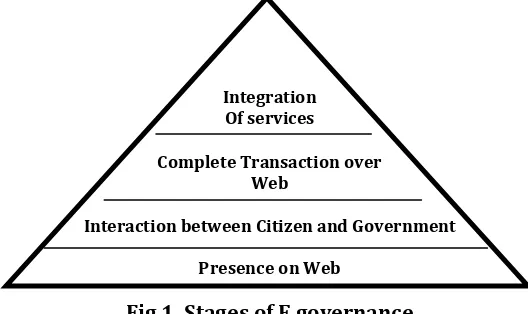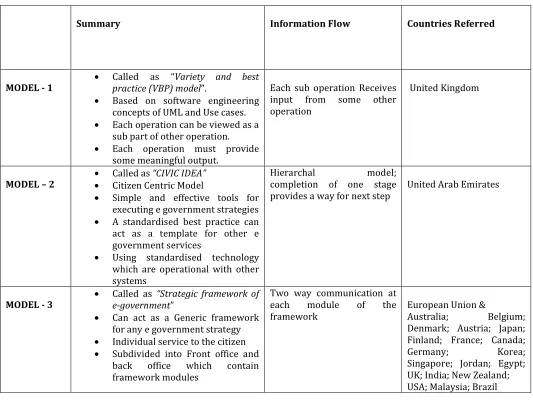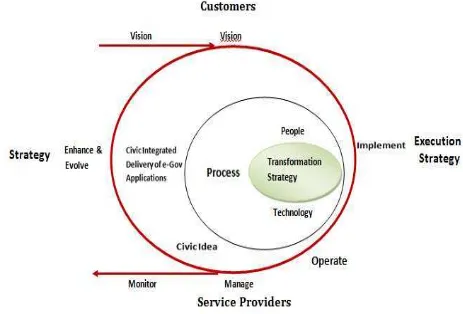Best Practices in E government: A review of Some
Innovative Models Proposed in Different Countries
Sami M. Alhomod and Mohd Mudasir Shafi
E Learning and Distance Learning Deanship, King Saud University, Riyadh, Saudi Arabia
E mails:
Alhomod@ksu.edu.sa
;
Mmudasir@ksu.edu.sa
Abstract---Governments all around the world are heavily investing towards the implementation of e government to improve services to citizens and reduce costs. With the help of ICT, governments can increase efficiency of their operations and can carry out their administrative operations smoothly. Keeping this fact in mind we thought to carry out research identifying the models for international best practices in e government. This paper offers a comparative study of three models and frameworks concerning the development of best practices in e government. The paper reviews each model in detail and provides a view of how each model can help towards the development of best practice in any e government initiative.
Keywords-
B
est Practices, Citizens, E governance Models, ServicesI. INTRODUCTION
The advancement in Information and communication technology (ICT) has affected our relation with people, businesses and more recently with governments [1]. The Introduction of ICT’s has changed the way governments interact with its citizens and has led to development of a world phenomenon called e government. E-government involves the use of the ICT to facilitate an efficient, speedy and transparent process of providing information to the public and to carry out administration activities.
The definition of E government according to World Bank is [2]:
“E-government refers to the use by government agencies of information technologies like wide area network, the internet and mobile computing that have the ability to transform relations with citizens, businesses, and other arms of government”
E-government uses information and communication technologies to promote more efficient and effective government, facilitate more accessible government services, allow greater public access to information and make government more accountable to citizens. The modern information technology services like the internet, mobile communication, wireless devices and a mix of other technologies are used to implement e government solutions. The main aim of e government is to provide an
easier access to information and services by using the modern technologies as well as facilitate better communication between different arms of the government. There are two extremely important criteria’s for a successful e government [3]:
A. 24 x 7 Availability: The E government services and transactions have to be available 24 hours a day, 7 days a week. A user should be able to access an e government service any time he wishes. This enables user to access services outside office hours.
B. Accessibility: Any e government initiative is critically dependent on accessibility of its services. If a particular service is not available to its intended target user, it will not be successful and will ultimately fail.
This paper is an in-depth exploration of three innovative approaches aimed towards making of an e government initiative into a best practice. The paper also tries to find common points in all the three models and as well determines the focal point of each of the models. The rest of the paper is organized in four sections: First, an introduction to the stages of e governance will be presented. Secondly, a brief overview of a best practice will be given. Next, the three models will be explained in detail. And at last a conclusion of the study and future work will be proposed.
II. STAGES OF E GOVERNANCE
Integration Of services
Complete Transaction over Web
Interaction between Citizen and Government
Presence on Web
Fig 1. Stages of E governance
A. Presence on the web:: The first stage on any e government is marked by its presence on the web which acts as a common place for distributing information to the public. It is the most basic part of any e governance system and has limited capabilities. An example of this stage can be a government website which provides only information but has no interaction capabilities [5, 6].
B. Interaction between citizen and governments: This second stage is marked by the presence of an interactive web interface where some kind of communication occurs between government and its citizens through the web. The objective of this stage is to automate government functions, which may include simple task of downloading forms of e mailing to the concerned authority [6].
C. Complete Transaction over Web: This stage involves transaction between a citizen and government being completed over the internet. This stage is fairly complex and enables citizens to complete entire tasks at any time either day or night [6]. Payment of bills & taxes can be attributed to this stage.
D. Integration of services: This is the highest level of any e government where technology is utilized to its full potential. This stage determines how e government functions are introduced, organized and carried out. In this stage, various government departments share information among each other and also offer services to the citizens online.
III. WHAT’S A BEST PRACTICE?
A best practice can be defined as an increased efficiency of the system for dissemination of the information, delivery of services and assisting in public decision making. A best practice is a standardized technique, method or a process that has proven themselves to accomplish tasks over a period of time. The UN defines a best practice as successful initiatives towards improving people’s standard of life. A
between public and private entities and is socially and culturally self-sufficient. Governments all around the world are striving to deliver high-quality services with the help of already established best practices in both public and private sectors [5].
There are six key similarities among best practices as identified by Ministry of Information Technology, Government of India:
• Constant focus on improvement in quality, costs and delivery of the e government services.
• Closer interaction with the citizens
• Closer interaction within the service providers
• Increased and effective use of technology.
• Greater flexibility and Less hierarchical organization
• Promoting continuous learning, teamwork, participation and flexibility
IV. E GOVERNMENT BEST PRACTICES MODELS
MODEL -1
Owen A., Johnson and Stephen F. King in 2005 demonstrated the application of Variety and best practice (VBP) model using the basic software engineering theory and techniques to identify best practices in local e governments. They argued that the software services that can be embedded into generic software solutions can be used for a large variety of complex e government operations. They proposed their model on the founding principle of the object-oriented systems called Inheritance. Inheritance can be defined as the process in which one sub operation inherits the characteristics of the parent operation. They said that any process or operation can be shown visually with the help of Unified modelling language (UML). The UML offers a graphical representation of any operation.
The construction of Variety and best practice (VBP) model was based on four points:
1. Any process or operation must provide a logical and meaningful outcome to customers, citizens and can be graphically shown with the help of use cases.
2. An operation or process can be shown as a part of some other operation and must provide a meaningful outcome.
4. The activities that take place during the completion of an operation or process can be represented in the form of UML activity diagrams, and inheritance can be applied to common operations and best practices.
The authors demonstrated the application of VBP model on the BASE.GOV project of the UK government. They used the use case diagram for showing the services provided by the local authority and UML activity diagram to model the best practice. The services provided by the local government can be represented in a single-use case diagram. A citizen can demand any type of service from the local government depending on his needs, and the VBP model can provide the view of best practices provided by the authorities. The model showed that the best practice can be modeled at different levels of operation and the level at which best practice can be implemented.
MODEL – 2
The second model in consideration was proposed by Ali M. Al-Khouri in 2011, which focused on developing simple and effective tools and strategies for managing, understanding and executing e government initiatives. The model proposed is called " Citizen inclusive vision realized through ID card Integrated Delivery of E-government Applications” simply referred to as “CIVIC IDEA." The model was concerned with the realization of e government initiatives in UAE. A figure showing the overall ecosystem of CIVIC IDEA is given at the end of this paper.
The CIVIC IDEA model proposed that a strategy for e governance and the right execution of the strategy are equally important for the delivery of e government services. The inference taken from the CIVIC IDEA concept is that a standardized best practice can act as a template for e government services provided at the local and central level of e government. The CIVIC IDEA strongly advocates the need to use standardized technologies complying with international standards and their interoperability between different systems. There are four stages of CIVIC IDEA realization:
1. Enable: In this phase, the basic foundation for the service is laid.
2. Enhance: This phase used to develop standards, infrastructure for the service.
3. Establish: This phase deals with increasing the demand of the service and also to extend support to other systems.
4. Expansion: The service is now expanded to reach maximum coverage.
The proposed framework is developed to aid in overall strategy and focus on certain best-practice development in an e government initiative.
Model– 3
The third model under review was proposed by Abdelbaset Rabaiah and Eddy Vandijck in 2009. This model is the result of review of e government strategies of 20 countries in addition to European Union. The paper proposed a generic framework that can be adopted by any e government strategy. They argued that the framework should act as a bridge between local and central government. The framework proposes that there can be strategies developed for individual services to be provided to the citizens. The framework is called strategic
The framework is further divided into two parts:
1. Front Office: Deals with following modules of the framework; Vision, Strategic objectives, Users, Delivery modes, Guiding principles, Channels, 2. Back Office: Deals with the remaining modules of;
Priority area, Major initiatives, Infrastructure, Organisation, Guidelines.
V.
CONCLUSION & FUTURE WORK
The above discussed models demonstrated different models which can be applied to numerous areas of e governance in different countries. The striking thing about
the three models is that each model was applied to one area of e governance but has flexibility of being extended to other areas of governance. The summary of the models is given in the following table:
Summary Information Flow Countries Referred
MODEL - 1
• Called as “Variety and best practice (VBP) model”.
• Based on software engineering concepts of UML and Use cases.
• Each operation can be viewed as a sub part of other operation.
• Each operation must provide some meaningful output.
Each sub operation Receives input from some other operation
United Kingdom
MODEL – 2
• Called as “CIVIC IDEA”
• Citizen Centric Model
• Simple and effective tools for executing e government strategies
• A standardised best practice can act as a template for other e government services
• Using standardised technology which are operational with other systems
Hierarchal model; completion of one stage provides a way for next step
United Arab Emirates
MODEL - 3
• Called as “Strategic framework of e-government”
• Can act as a Generic framework for any e government strategy
• Individual service to the citizen
• Subdivided into Front office and back office which contain framework modules
Two way communication at each module of the framework
European Union &
Australia; Belgium; Denmark; Austria; Japan; Finland; France; Canada; Germany; Korea; Singapore; Jordan; Egypt; UK; India; New Zealand; USA; Malaysia; Brazil
TABLE 1: Summary of the Discussed Models
REFERENCES
[1] Abdullah AL-Shehry , Simon Rogerson, N. Ben Fairweather, Mary Prior “the motivations for change towards e-government adoption: case studies from saudi arabia ” eGovernment Workshop ’06 September 11 2006, Brunel University, West London
[2] World Bank, 2002
http://www.worldbank.org/12-3-2009
[3] Abdulmohsen Abanumy, Ali Al-Badi and Pam Mayhew "e-Government Website Accessibility: In-Depth Evaluation of Saudi Arabia and Oman" The Electronic Journal of e-Government Volume 3 Issue 3 pp 99-106
[4] Zahir Irani, Madi Al-Sebie and Tony
Elliman"Transaction Stage of e-Government Systems: Identification of its Location & Importance"Proceedings of the 39th Hawaii International Conference on System Sciences – 2006
[5] E-Governance And Best Practices
http://india.gov.in/govt/studies/annex/6.3.1.pdf
[6] Owen A., Johnson and Stephen F. King 2005 "Best Practice In Local E-Government: A Process Modelling Approach" eGovernment Workshop ’05 (eGOV05), September 13 2005, Brunel University, West London
[7] Ali M. Al-Khouri "AN INNOVATIVE APPROACH FOR E-GOVERNMENT TRANSFORMATION " International Journal of Managing Value and Supply Chains (IJMVSC) Vol. 2, No. 1, March 2011
[8] Abdelbaset Rabaiah and Eddy Vandijck "A Strategic Framework of e-Government: Generic and Best Practice "
[9] Michael Blakemor “eGovernment strategy across Europe - a bricolage responding to societal challenge”
[10] Virpi Timonen, Orla O’Donnell, Peter C. Humphrey “E-GOVERNMENT AND THE DECENTRALISATION OF SERVICE DELIVER”
[11] Jeremy Millard “E-Government Strategies: Best Practice Reports From the European Front Line”
[12] Jeffrey W. Seifert, Glenn J. McLoughlin ” State E-Government Strategies: Identifying Best Practices and Applications”
[13] BuyIT ICT Best Practice Network (2005). The framework for e-Government “.
[14] Accenture (2005). Leadership in Customer Service: New Expectations, New Experiences. Accenture, April 2005.
[15] Bevir, M, Rhodes, R, Weller, P (2003). ‘Traditions of Governance: Interpreting the Changing Role of
the Public Sector’. Public Administration, 81(1), 1-17.
[16] Collinge, A (2003). ‘How and Where is Local Government Delivering Value to the Citizens?’ In: Local E-Government Now: Sustaining the Momentum: Briefing on SOCITIM and I&DeA Report.
[17] Leben, A & Vintar, M (2004). ‘Life-Event Approach: Comparison between Countries’. Lecture Notesin Computer Science, Electronic Government. Springer-Verlag, Heidelberg. 2739, 434 – 437.
[18] Moon, J.M (2002). ‘The evolution of e-government among municipalities: rhetoric or reality?’ Public Administration Review, 62(4), 424-433.


